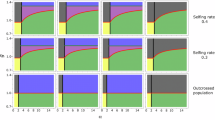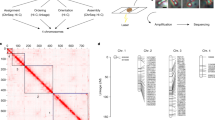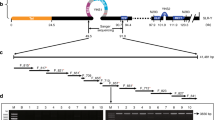Summary
Studies of the morphological polymorphism for the expression of male sterility in the gynodioecious species Plantago lanceolata revealed two separate series of stamen forms from sterile to fertile. The first type of complete male sterility (MS1) shows a disturbed development of the stamens, which are strongly reduced in size. The second type (MS2) has stamens which are petaloid. In the latter type the corolla and sometimes the pistil are also affected. Evidence is presented that these differences in expression of male sterility are cytoplasmically determined. The plasmon types are designated R and P respectively. In each plasmon type a series of intermediate sex forms occurs. Field counts showed that these intermediates are a non-negligible proportion of most populations. On the average MS1 reaches higher frequencies than MS2. Twenty two out of 27 populations appeared to be polymorphic for plasmon type. The remaining five populations are probably fixed for plasmon P and their distribution over the habitats studied suggests that the fitnesses of the different sex genotypes depend on environmental conditions.
Similar content being viewed by others
Article PDF
References
Alexander, M P. 1969. Differential staining of aborted and nonaborted pollen. Stain Techn, 44, 117–122.
Arroyo, M T K, and Raven, P H. 1975. The evolution of subdioecy in morphologically gynodioecious species of Fuchsia sect. Encliandra (Onagraceae). Evolution, 29, 500–511.
Baker, H G. 1963. Evolutionary mechanisms in pollination biology. Science, 139, 877–883.
Bartlett, H H. 1911. On gynodioecism in Plantago lanceolata. Rhodora, 13, 199–206.
Blaringhem, L. 1923. Etudes sur le polymorphisme floral. IV. Sexualité et métamorphose des épis de Plantago lanceolata L. Bull Soc botan France, 70, 717–725.
Brockmann, I, and Bocquet, G. 1978. Ökologische Einflüsse auf die Geschlechtsverteilung vei Silene vulgaris (Moench) Garcke (Caryophyllaceae). Ber Deutsch Bot Ges, 91, 217–230.
Caspari, E, Watson, G S, and Smith, W. 1966. The influence of cytoplasmic pollen sterility on gene exchange between populations. Genetics, 53, 741–746.
Chaplin, J F. 1964. Use of male sterile tobacco in the production of hybrid seed. Tobacco Sci, 8, 105–109.
Charlesworth, B, and Charlesworth, D. 1978a. A model for the evolution of dioecy and gynodioecy. Amer Nat, 112, 975–997.
Charlesworth, D. 1981. A further study of the problem of the maintenance of females in gynodioecious species. Heredity, 46, 27–39.
Charlesworth, D, and Charlesworth, B. 1978b. Population genetics of partial male-sterility and the evolution of monoecy and dioecy. Heredity, 41, 137–153.
Charlesworth, D, and Ganders, F R. 1979. The population genetics of gynodioecy with cytoplasmic-genic male-sterility. Heredity, 43, 213–218.
Coleman, N. 1876. Plantago lanceolata L. Bot Bull, 1, 45.
Connor, H E. 1973. Breeding systems in Cortaderia (Gramineae). Evolution, 27, 663–678.
Correns, C. Die Vererbung der Geschlechtsformen bei den gynodiöcischen Pflanzen. Ber Deutsch Bot Ges, 24, 459–474.
Correns, C. 1908. Die Rolle der männlichen Keimzellen bei der Geschlechtsbestimmung der gynodioecischen Pflanzen. Ber Deutsch Bot Ges, 26a, 686–701.
Costatino, R F. 1971. Genetic consequences of the couplet cytoplasmic pollen sterility and pollen migration. Genetics, 68, 313–321.
Darwin, C. 1877. Different Forms of Flowers on Plants of the Same Species. John Murray, London.
Delannay, X, Gouyon, P H, and Valdeyron, G. 1981. Mathematical study of the evolution of gynodioecy with cytoplasmic inheritance under the effect of a nuclear restorer gene. Genetics, 99, 169–181.
Dommee, B, Assouad, M W, and Valdeyron, G. 1978. Natural selection and gynodioecy in Thymus vulgaris L. Bot J Linn Soc, 77, 17–28.
Edwardson, J R. 1970. Cytoplasmic male sterility. Bot Rev, 36, 341–420.
Frankel, R, and Galun, E. 1977. Pollination Mechanisms, Reproduction and Plant Breeding. Monographs on Theoretical and Applied Genetics 2, Springer-Verlag, Berlin.
Ganders, F R. 1978. The genetics and evolution of gynodioecy in Nemophila menziesii (Hydrophyllaceae). Can J Bot, 56, 1400–1408.
Georgescu, C M, Römer, D, and Olteanu, Gh. 1979. Peroxidase activity as a possible test for distinguishing S-plasm from N-plasm in sugar beet (Beta vulgaris L.). Euphytica, 28, 779–784.
Gottschalk, W, and Kaul, M L H. 1974. The genetic control of microsporogenesis in higher plants. Nucleus (Calcutta), 17, 133–166.
Grun, P. 1976. Cytoplasmic Genetics and Evolution. Columbia Univ. Press, New York.
Hope-Simpson, J F. 1939. Reduction of the androecium in Plantago lanceolata L. J Bot, 77, 290–293.
Jones, H A, and Emsweller, S L. 1936. A male-sterile onion. Proc Am Soc hort Sci, 34, 582–585.
Kemble, R J. 1980. A rapid, single leaf assay for detecting the presence of “S”-male-sterile cytoplasm in maize. Theor Appl Genet, 57, 97–100.
Kemble, R J, Gunn, R E, and Flavell, R B. 1980. Classification of normal and male-sterile cytoplasms in maize. II. Electrophoretic analysis of DNA species in mitochondria. Genetics, 95, 451–458.
Kheyr-Pour, A. 1980. Nucleo-cytoplasmic polymorphism for male sterility in Origanum vulgare L. J Hered, 71, 253–260.
Kheyr-Pour, A. 1981. Wide nucleo-cytoplasmic polymorphism for male sterility in Origanum vulgare L. J Hered, 72, 45–51.
Krohne, D T, Baker, I, and Baker, H G. 1980. The maintenance of the gynodioecious breeding system in Plantago lanceolata L. Amer Midi Natur, 103, 269–279.
Lewis, D. 1941. Male sterility in natural populations of hermaphrodite plants. New Phytol, 40, 56–63.
Lloyd, D G, and Webb, C J. 1977. Secondary sex characters in seed plants. Bot Rev, 43, 177–216.
Ludwig, F. 1879. Ueber die Blütenformen von Plantago lanceolata L. und die Erscheinung der Gynodiöcie. Z ges Naturwiss, 52, 441–449.
Meyer, J R, and Meyer, N G. 1961. Cytoplasmic male sterility in cotton.. Genetics, 46, 883.
Meyer, V G. 1966. Flower abnormalities. Bot Rev, 32, 165–218.
Morelock, T E. 1974. Influence of Cytoplasmic Source on Expression of Male Sterility in Carrot, D carota. Ph.D. Thesis, Univ. of Wisconsin.
Primack, R B. 1978. Evolutionary aspects of wind pollination in the genus Plantago (Plantaginaceae). New Phytol, 81, 449–458.
Pearson, O H. 1972. Cytoplasmically inherited male sterility characters and flavor components from the species cross Brassica nigra (L.) Koch × B. oleracea L. J Am Soc Hort Sci, 97, 397–402.
Ross, M D. 1967. Two genetic mechanisms governing outbreeding in Plantago lanceolata. Genetics, 56, 584–585.
Ross, M D. 1969. Digenic inheritance of male sterility in Plantago lanceolata. Can J Genet Cytol, 11, 739–744.
Ross, M D. 1973. Inheritance of self-incompatibility in Plantago lanceolata. Heredity, 30, 169–176.
Ross, M D. 1978. The evolution of gynodioecy and subdioecy. Evolution, 32, 174–188.
Ross, M D, and Weir, B S. 1976. Maintenance of males and females in hermaphrodite populations and the evolution of dioecy. Evolution, 30, 425–441.
Schulz, A. 1888. Beitäage zur Kenntnis der Bestäubungseinrichtungen und Geschlechtsverteilung bei den Pflanzen. Bibl Botan, 10, 90–93.
Stout, A B. 1919. Intersexes in Plantago lanceolata. Bot Gaz, 68, 109–133.
Troelstra, S R, Sluimer, L, Smant, W, Wagenaar, R, and Van Der Meulen, M A. 1981. On the soil chemistry of natural habitats of Plantago species and Hypochaeris radicata in various parts of the Netherlands in relation to the chemical composition of the plants. Verh Kon Ned Acad Wetensch, Afd Natuurk 2e Reeks, 77, Progress Report 1980 I.O.O., 20–32.
Turrill, W B. 1919. Female flowers in Plantago lanceolata. J Bot, 57, 196.
Valdeyron, G, Assouad, W, and Dommee, B. 1970. Coexistance des déterminismes genique et cytoplasmique de la sterilité male. In La Sterilité Male Chez les Plantes Horticoles. Eucarpia meeting Versailles, 175–186.
Van Der Mer, Q P. 1977. Ui. IVT Annual Report 1976, 25–27.
Watson, G S, and Caspari, E. 1960. The behaviour of cytoplasmic pollen sterility in populations. Evolution, 14, 56–63.
Webb, C J. 1979. Breeding systems and the evolution of dioecy in New Zealand apioid Umbelliferae. Evolution, 33, 662–672.
Author information
Authors and Affiliations
Additional information
Grassland Species Research Group Publication No. 54.
Rights and permissions
About this article
Cite this article
van Damme, J., van Delden, W. Gynodioecy in Plantago lanceolata L I. polymorphism for plasmon type. Heredity 49, 303–318 (1982). https://doi.org/10.1038/hdy.1982.104
Received:
Issue date:
DOI: https://doi.org/10.1038/hdy.1982.104
This article is cited by
-
Progressive programmed cell death inwards across the anther wall in male sterile flowers of the gynodioecious plant Plantago lanceolata
Planta (2019)
-
Sexually-trimorphic interactions with colour polymorphism determine nectar quality in a herbaceous perennial
Scientific Reports (2017)
-
Frequent, geographically structured heteroplasmy in the mitochondria of a flowering plant, ribwort plantain (Plantago lanceolata)
Heredity (2016)
-
Patterns of male sterility within and among populations of the distylous shrub Erythroxylum havanense (erythroxylaceae)
Plant Ecology (2005)
-
Multiple CMS–restorer gene polymorphism in gynodioecious Plantago coronopus
Heredity (2004)



